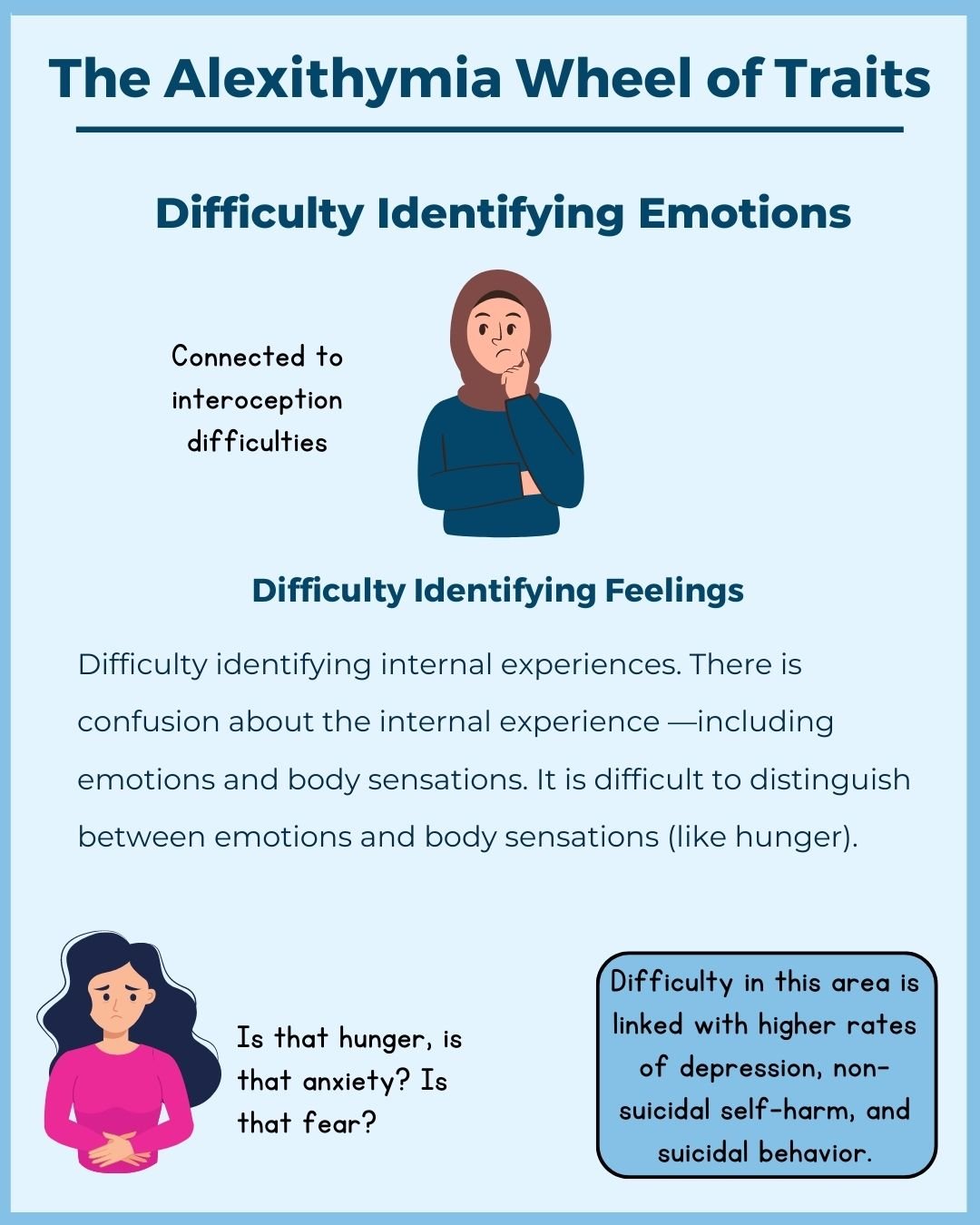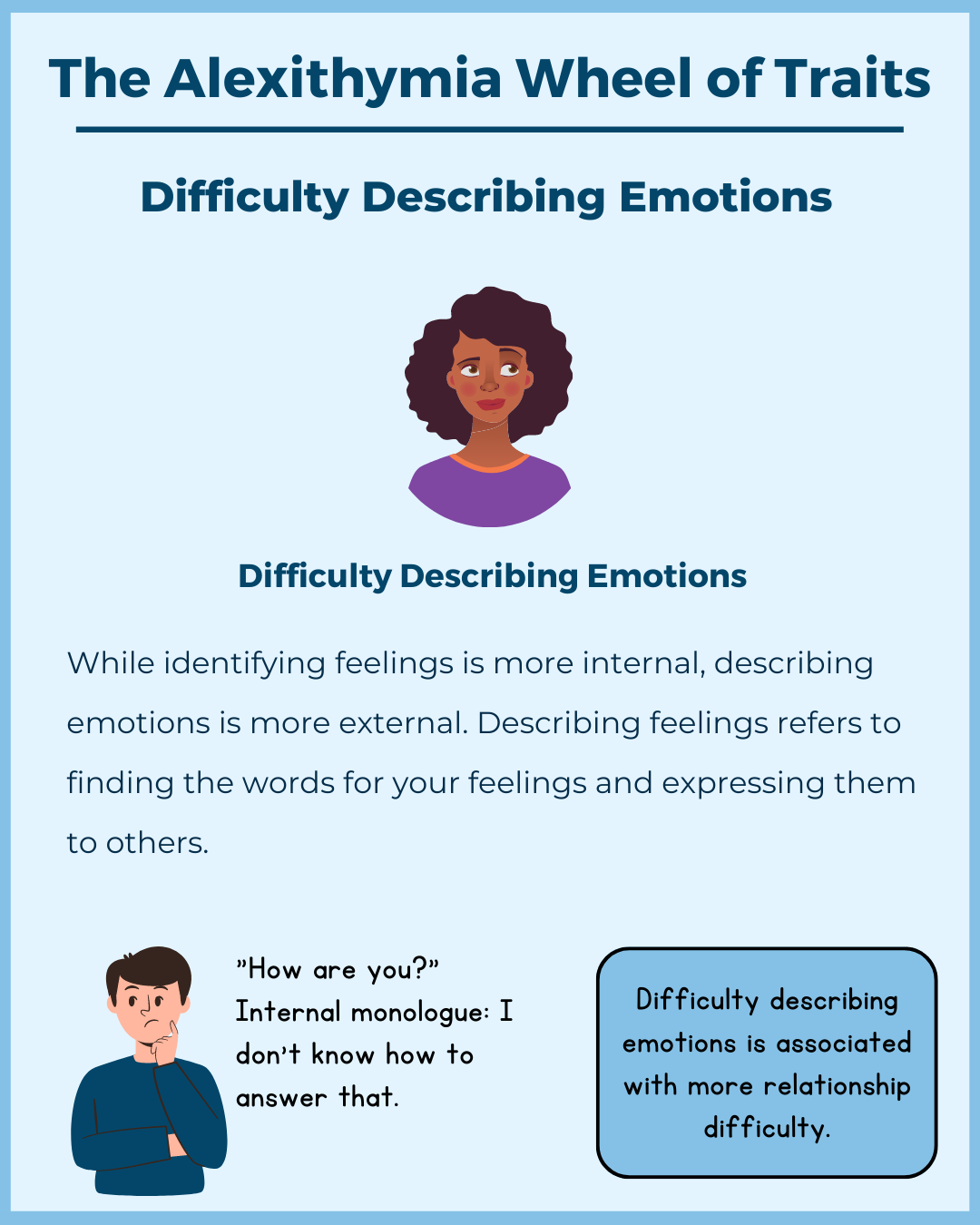Alexithymia Traits Explained: An Introduction to the Alexithymia Wheel of Traits
Have you ever struggled to put your feelings into words? Do you often find yourself feeling disconnected from your emotions, or unsure of how to describe what you're feeling? If so, you may be familiar with a condition called alexithymia. As someone who experiences alexithymia myself, I understand the challenges of navigating this complex and often misunderstood condition. In a previous post, we explored what alexithymia is (and what causes it).
Today, we'll take a closer look at alexithymic traits and what they can look like in different people. It's important to note that alexithymia occurs on a spectrum, and that there is no universally agreed-upon definition of what is included in alexithymic traits. While most people agree on a core three or four traits, other measurements like the Online Alexithymia Test include seven traits. Despite this complexity, understanding these traits can be a crucial step towards improving emotional awareness and regulation, so let’s take a closer look at seven alexithymic traits.
The Alexithymia Wheel of Traits
The Alexithymia Wheel takes the 7 traits used in the Online Alexithymia Measure and visualizes them as a wheel. The Alexithymia wheel of traits is not an official thing. My ADHD brain loves to mash ideas, and that is precisely what I am doing here! I am taking the concept of the Autistic wheel of traits and applying it to alexithymia. Personally, I like the visualization of the wheel as it allows you to look at the traits side by side. This allows you to see areas of difference. But if you prefer something more linear, then you will like the slider graphs provided on the results page of the Online Alexithymia Measure.
The Seven Alexithymic Traits
There are also several different factors of alexithymia. The Online Alexithymia Measure captures seven areas where a person may experience alexithymic traits. A person may have alexithymia in some areas but not in others.
Difficulty Identifying Feelings
Difficulty Describing Feelings
Externally Oriented Thinking
Vicarious Interpretation of Feeling
Restricted Imaginative Processes
Interpersonal Relationship Difficulties
Sexual Difficulties and Disinterest
*Note the last two are not actual alexithymic traits but commonly occur in people who have high levels of alexithymic traits.
Alexithymic Trait One: Difficulty Identifying Emotions
People with high alexithymic traits in this area have difficulty identifying internal experiences. They often experience a great deal of confusion about their internal experience —including emotions and body sensations. Their bodily sensations often cause confusion, and they struggle to distinguish between emotions and bodily sensations (for example, the difference between hunger and anxiety).
For children, they may frequently complain of stomach pains and general feelings of not feeling well. Many of their emotions will be experienced as somatic pains and so when they’re talking about physical complaints they may be communicating something important about their emotions! As a parent, it can be difficult to tell the difference between a genuine physical ailment and a somatic symptom of their emotional state!
Difficulty in this area is linked with depression, non-suicidal self-harm, and suicidal behavior (Cerutti et al., 2018). Identifying emotions play a crucial role in our ability to regulate emotions which is likely one of the reasons this is connected with more emotional turmoil and depression. It is common for Autistic people to have high alexithymic traits in this area.
*Note: This is often connected to underlying interoception difficulties.
Alexithymic Trait Two: Difficulty Describing Feelings
While difficulty describing feelings sounds similar to identifying feelings, it is slightly different. While identifying feelings is more internal, describing emotions is more external. Difficulty describing feelings refers to difficulty with:
Finding words for your feelings and
Being able to express these feelings to others
People who struggle with this experience difficulty labeling emotions and finding the right words to describe their feelings. Descriptors of emotions may be vague, general, and diffuse.
Difficulty describing emotions is associated with more relationship difficulty.
Dr. Neff note: I observe that Autistic people tend to have different access points to their inner world. For example, I don't typically connect with people by talking directly about emotions. However, I introduce my inner landscape to people by talking about my passions and interests, which often then connect to conversations of emotions (indirectly). I also find this tends to be the entry point by which many of my Autistic clients introduce me to their inner landscape.
Alexithymic Trait Three: External-Oriented Thinking
Externally oriented thinking occurs when a person's thoughts are focused externally (vs. internally). An externally oriented thinker focuses their energy on external events and tends to avoid focusing on internal experiences.
When a person has high alexithymic traits in this area, they experience difficulty attending to their emotions and inner states. There is a lack of curiosity about what is happening internally for the person.
Alexithymic Trait Four: Vicarious Interpretation of Feeling
People with high alexithymic traits in this area have difficulty identifying and understanding their own emotions, as well as recognizing emotions in others. This can lead them to rely on others to interpret emotions and provide guidance on how to respond in social situations. For example, they may ask others how they would feel in a given situation to try and understand their emotional response.
Additionally, they may struggle to accurately read and understand the emotions of others, which can impact their relationships. This ability to understand what others are experiencing is a key role in developing relationships and creating strong interpersonal connections. People with high alexithymic traits in this area often experience more relationship difficulties.
Note: Vicarious interpretation of feelings is not always considered a core component of alexithymia, although it is often correlated or linked with the core dimensions of alexithymia.
Alexithymic Trait Five: Restricted Imaginative Processes
Many people with alexithymia (but not all) have a diminished fantasy life with limited imaginative capacities. A restricted imagination is characterized by diminished fantasy life with limited interest in or ability to engage the imagination.
People with high alexithymic traits here are oriented toward the concrete world of facts and pragmatics with little interest in fantasy and imaginative processes. They may have little interest in fantasy, creative efforts, and art and are unlikely to spend time daydreaming.
Alexithymic Trait Six: Interpersonal Relationship Difficulties
The last two subscales, problematic interpersonal relationships, and sexual difficulties/disinterest, aren’t specifically part of the formal definition of alexithymia but often correlate with alexithymia.
Alexithymia has been linked to difficulties with empathy (difficulty perceiving other people's perspectives and understanding their feelings and intentions) (Goerlich, 2018), making and deepening relationships more difficult.
One study found that alexithymia rather than autism led to difficulties in cognitive and affective empathy. Autistic people who did not also have alexithymia did not have the same struggles with emotion recognition and empathy as Autistic people with alexithymia. This has led some researchers to believe it is alexithymia and not autism that results in difficulty with empathy (Bird and Viding, 2014). This theory is known as the “Alexithymia theory.” The "Alexithymia hypothesis" is that the difficulty with emotion recognition and empathy often attributed to autism is actually due to alexithymia, not autism and that these difficulties are not intrinsic to autism itself.
Alexithymic Trait Seven: Sexual Difficulties and Disinterest
While not a primary feature of alexithymia, alexithymia is often connected to sexual difficulties. Such as reduced sexual satisfaction and greater detachment from sexual partners.
This may be related to several factors:
1) alexithymia is associated with more negative emotions, which impact sexual attitudes
2) alexithymia often results in a more avoidant/detached attachment style, which lends to a more avoidant sexual style (Scimeca et al., 2013).
People with alexithymia are also more likely to identify as asexual (source). This may be one reason there is a higher rate of asexual people within the Autistic population.
The Alexithymic Wheel of Traits
Just like Autistic and ADHD traits exist on the "wheel of traits," there is also a wheel of alexithymic traits. A person can have high alexithymic traits in some areas and low alexithymic traits in others.
The wheel of traits is a helpful way of considering how alexithymia can present differently from person to person.
Summary
In this blog post, we delved into the concept of alexithymia and explored some of its key traits. If you want to learn more about how to measure alexithymia, check out my review of alexithymia tests here and find links to common online alexithymia screeners.
If you are a parent or therapist and want more of a deep dive into alexithymia (what it is, how it influences our physical and mental health, and how to work with it in therapy), you can check out the training I did with Therasmart here.







